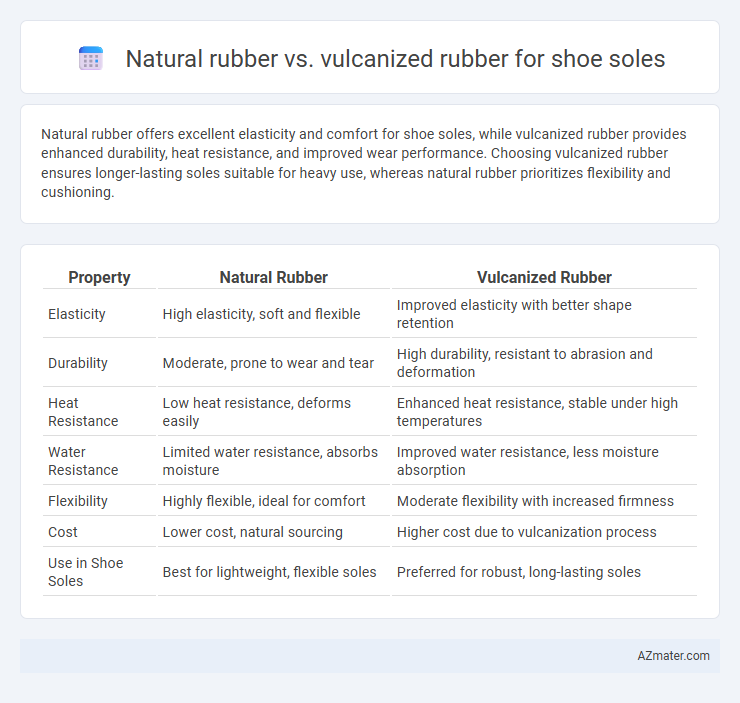Natural rubber offers excellent elasticity and comfort for shoe soles, while vulcanized rubber provides enhanced durability, heat resistance, and improved wear performance. Choosing vulcanized rubber ensures longer-lasting soles suitable for heavy use, whereas natural rubber prioritizes flexibility and cushioning.
Table of Comparison
| Property | Natural Rubber | Vulcanized Rubber |
|---|---|---|
| Elasticity | High elasticity, soft and flexible | Improved elasticity with better shape retention |
| Durability | Moderate, prone to wear and tear | High durability, resistant to abrasion and deformation |
| Heat Resistance | Low heat resistance, deforms easily | Enhanced heat resistance, stable under high temperatures |
| Water Resistance | Limited water resistance, absorbs moisture | Improved water resistance, less moisture absorption |
| Flexibility | Highly flexible, ideal for comfort | Moderate flexibility with increased firmness |
| Cost | Lower cost, natural sourcing | Higher cost due to vulcanization process |
| Use in Shoe Soles | Best for lightweight, flexible soles | Preferred for robust, long-lasting soles |
Introduction to Rubber in Shoe Soles
Natural rubber offers excellent flexibility, elasticity, and comfort for shoe soles but lacks resistance to heat, abrasion, and aging, leading to quicker wear. Vulcanized rubber enhances natural rubber by introducing sulfur cross-links, significantly improving durability, heat resistance, and mechanical strength, making it ideal for long-lasting shoe soles. These properties ensure vulcanized rubber soles provide superior performance in diverse environmental conditions compared to untreated natural rubber.
What is Natural Rubber?
Natural rubber, derived from the latex sap of Hevea brasiliensis trees, is prized for its elasticity, resilience, and biodegradability, making it a popular choice for shoe soles that require flexibility and comfort. This untreated rubber is soft and exhibits excellent tensile strength but lacks the durability and heat resistance needed for prolonged use or harsh environments. Its natural composition offers eco-friendly benefits but requires modification, like vulcanization, to enhance performance for more demanding footwear applications.
Understanding Vulcanized Rubber
Vulcanized rubber is natural rubber treated with sulfur and heat, enhancing its durability, elasticity, and resistance to abrasion, making it ideal for shoe soles exposed to rigorous wear. This process creates cross-links between polymer chains, improving mechanical properties and preventing deformation under stress compared to untreated natural rubber. Consequently, vulcanized rubber offers superior traction, weather resistance, and longevity for footwear applications.
Key Differences: Natural vs Vulcanized Rubber
Natural rubber offers high elasticity and flexibility, making it ideal for comfortable shoe soles, but it has limited resistance to heat, abrasion, and aging. Vulcanized rubber, produced by heating natural rubber with sulfur, significantly improves durability, elasticity, and resistance to wear and environmental factors, enhancing shoe sole longevity. Key differences include vulcanized rubber's enhanced tensile strength, improved hardness, and superior resistance to chemicals and temperature variations compared to natural rubber.
Durability and Wear Resistance
Vulcanized rubber offers superior durability and wear resistance compared to natural rubber, due to its cross-linked sulfur bonds that enhance elasticity and strength. Natural rubber tends to degrade faster under mechanical stress and exposure to heat or chemicals, making it less ideal for shoe soles requiring long-lasting performance. Shoe soles made from vulcanized rubber withstand abrasion, maintain flexibility, and resist cracking, which significantly extends their service life.
Flexibility and Comfort Comparison
Natural rubber soles provide superior flexibility due to their untreated polymer chains, allowing for greater stretch and natural foot movement. Vulcanized rubber soles, treated with sulfur and heat, offer enhanced durability and resistance to wear but tend to be stiffer, reducing overall comfort for long-term wear. The choice between the two depends on prioritizing either the softness and flexibility of natural rubber or the toughness and longevity of vulcanized rubber in shoe soles.
Traction and Performance on Different Surfaces
Natural rubber offers excellent traction on wet and dry surfaces due to its high elasticity and grip, making it ideal for shoe soles requiring flexibility and shock absorption. Vulcanized rubber, treated with sulfur to enhance durability and resistance to abrasion, provides superior performance on rough and abrasive surfaces by maintaining structural integrity under stress. While natural rubber excels in comfort and traction on smooth, slippery terrains, vulcanized rubber outperforms in long-term wear and stability across diverse and rugged environments.
Environmental Impact and Sustainability
Natural rubber used in shoe soles is biodegradable and sourced from renewable Hevea brasiliensis trees, making it a more sustainable option compared to vulcanized rubber, which undergoes chemical processes with sulfur and other agents that hinder recycling and increase environmental pollution. The vulcanization process enhances durability and heat resistance but results in a cross-linked polymer structure that resists natural degradation, contributing to landfill accumulation and microplastic pollution. Choosing natural rubber reduces carbon footprint and waste, supporting eco-friendly footwear production that aligns with circular economy principles.
Cost Considerations for Shoe Manufacturers
Natural rubber offers a cost-effective raw material option for shoe sole production, with lower initial expenses due to its availability and minimal processing requirements. Vulcanized rubber, however, incurs higher production costs because of the additional vulcanization process that enhances durability and elasticity, justifying its premium pricing in the final product. Shoe manufacturers must balance the upfront expense of vulcanized rubber against its long-term performance benefits to optimize overall cost-efficiency.
Which Rubber is Best for Your Shoe Sole Needs?
Natural rubber offers excellent flexibility, cushioning, and grip, making it ideal for lightweight, comfortable shoe soles. Vulcanized rubber undergoes a heat treatment process that enhances durability, abrasion resistance, and elasticity, which is essential for high-performance and long-lasting footwear. Choosing between natural and vulcanized rubber depends on your shoe sole requirements: prioritize natural rubber for comfort and flexibility, while vulcanized rubber suits durability and heavy-duty wear.

Infographic: Natural rubber vs Vulcanized rubber for Shoe sole
 azmater.com
azmater.com